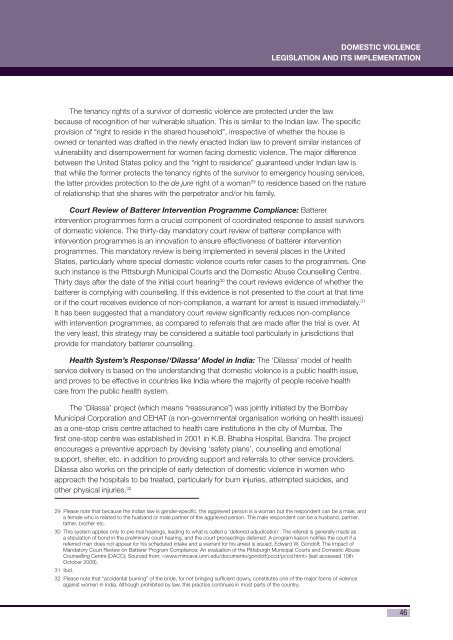Domestic Violence Legislation and its Implementation
Domestic Violence Legislation and its Implementation
Domestic Violence Legislation and its Implementation
Create successful ePaper yourself
Turn your PDF publications into a flip-book with our unique Google optimized e-Paper software.
DOMESTIC VIOLENCE<br />
LEGISLATION AND ITS IMPLEMENTATION<br />
The tenancy rights of a survivor of domestic violence are protected under the law<br />
because of recognition of her vulnerable situation. This is similar to the Indian law. The specifi c<br />
provision of “right to reside in the shared household”, irrespective of whether the house is<br />
owned or tenanted was drafted in the newly enacted Indian law to prevent similar instances of<br />
vulnerability <strong>and</strong> disempowerment for women facing domestic violence. The major difference<br />
between the United States policy <strong>and</strong> the “right to residence” guaranteed under Indian law is<br />
that while the former protects the tenancy rights of the survivor to emergency housing services,<br />
the latter provides protection to the de jure right of a woman 29 to residence based on the nature<br />
of relationship that she shares with the perpetrator <strong>and</strong>/or his family.<br />
Court Review of Batterer Intervention Programme Compliance: Batterer<br />
intervention programmes form a crucial component of coordinated response to assist survivors<br />
of domestic violence. The thirty-day m<strong>and</strong>atory court review of batterer compliance with<br />
intervention programmes is an innovation to ensure effectiveness of batterer intervention<br />
programmes. This m<strong>and</strong>atory review is being implemented in several places in the United<br />
States, particularly where special domestic violence courts refer cases to the programmes. One<br />
such instance is the Pittsburgh Municipal Courts <strong>and</strong> the <strong>Domestic</strong> Abuse Counselling Centre.<br />
Thirty days after the date of the initial court hearing 30 the court reviews evidence of whether the<br />
batterer is complying with counselling. If this evidence is not presented to the court at that time<br />
or if the court receives evidence of non-compliance, a warrant for arrest is issued immediately. 31<br />
It has been suggested that a m<strong>and</strong>atory court review signifi cantly reduces non-compliance<br />
with intervention programmes, as compared to referrals that are made after the trial is over. At<br />
the very least, this strategy may be considered a suitable tool particularly in jurisdictions that<br />
provide for m<strong>and</strong>atory batterer counselling.<br />
Health System’s Response/‘Dilassa’ Model in India: The ‘Dilassa’ model of health<br />
service delivery is based on the underst<strong>and</strong>ing that domestic violence is a public health issue,<br />
<strong>and</strong> proves to be effective in countries like India where the majority of people receive health<br />
care from the public health system.<br />
The ‘Dilassa’ project (which means “reassurance”) was jointly initiated by the Bombay<br />
Municipal Corporation <strong>and</strong> CEHAT (a non-governmental organisation working on health issues)<br />
as a one-stop crisis centre attached to health care institutions in the city of Mumbai. The<br />
fi rst one-stop centre was established in 2001 in K.B. Bhabha Hospital, B<strong>and</strong>ra. The project<br />
encourages a preventive approach by devising ‘safety plans’, counselling <strong>and</strong> emotional<br />
support, shelter, etc. in addition to providing support <strong>and</strong> referrals to other service providers.<br />
Dilassa also works on the principle of early detection of domestic violence in women who<br />
approach the hospitals to be treated, particularly for burn injuries, attempted suicides, <strong>and</strong><br />
other physical injuries. 32<br />
29 Please note that because the Indian law is gender-specifi c, the aggrieved person is a woman but the respondent can be a male, <strong>and</strong><br />
a female who is related to the husb<strong>and</strong> or male partner of the aggrieved person. The male respondent can be a husb<strong>and</strong>, partner,<br />
father, brother etc.<br />
30 This system applies only to pre-trial hearings, leading to what is called a ‘deferred adjudication’. The referral is generally made as<br />
a stipulation of bond in the preliminary court hearing, <strong>and</strong> the court proceedings deferred. A program liaison notifi es the court if a<br />
referred man does not appear for his scheduled intake <strong>and</strong> a warrant for his arrest is issued. Edward W. Gondolf; The Impact of<br />
M<strong>and</strong>atory Court Review on Batterer Program Compliance: An evaluation of the Pittsburgh Municipal Courts <strong>and</strong> <strong>Domestic</strong> Abuse<br />
Counselling Centre (DACC); Sourced from: (last accessed 10th<br />
October 2008).<br />
31 Ibid.<br />
32 Please note that “accidental burning” of the bride, for not bringing suffi cient dowry, constitutes one of the major forms of violence<br />
against women in India. Although prohibited by law, this practice continues in most parts of the country.<br />
46

















